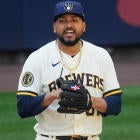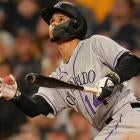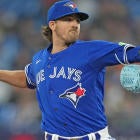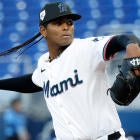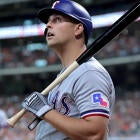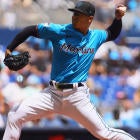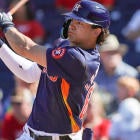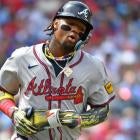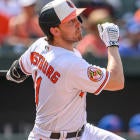Chances are you've heard of the tier approach in Fantasy Baseball by now. You may not understand what makes it so great, but you've heard of it.
Tiering in general shouldn't be a foreign concept to you. You see it in movie theaters, where each row is raised above the one in front of it to give everyone a better view. You see it in wedding cakes, with each layer getting smaller and smaller all the way to the top. Applied to Fantasy Baseball, it's the sorting of players within a position by level of talent, with the better ones obviously grouped above the lesser ones. Not so impressive, right? You've been sorting things since the first day you heard "One of These Things Is Not Like the Others." Great insight, oh wise one.
But if you dismiss the approach there, seeing it as just another frivolous task designed by frivolous people looking for a way to gain an advantage in a game that's almost all luck anyway, you're missing a real eye-opener. And you're being a negative Nancy.
The advantage of the tier approach isn't the sorting itself. It's what you do with the sorting.
If you have any investment in Fantasy Baseball whatsoever, chances are you've reviewed the player rankings already, and chances are you have a pretty good grasp of them by now. You know Albert Pujols is better than Joey Votto, for instance, and if you were drafting only first basemen, that's all you'd need to know. But you don't win in Fantasy simply by getting the best player at a particular position. You win by assembling the best team across the board. To do that, you need to know how quickly the talent dwindles at each position. The answer is in the tiers.
So how do you define tiers within a position? It depends on your format, the depth of your player pool and, more than anything, your own level of comfort. Try comparing two players listed next to each other in the position-by-position rankings. Can you say with any real assurance which of Brian McCann and Mike Napoli will have the more productive season? Of course not. It depends on how many at-bats Napoli gets in his rover role and how close he comes to repeating his second-half production. It depends on whether or not McCann's struggles late last season were injury-related or something more. Without knowing those answers, it's a complete toss-up. Thus, they belong in the same tier.
So if you get to a point on Draft Day when you're looking for a catcher and both McCann and Napoli are still on the board, why be the one to decide between the two if you've already established that they're more or less equals? If that's really the case, you shouldn't care which one you get. Target another position -- one closer to depletion at its highest available tier -- and grab whichever of McCann and Napoli falls to you with your next pick.
Granted, it's not always that simple. Depending on how many owners pick between your two picks and what exactly your needs are, you may be at risk of losing both McCann and Napoli if you don't grab one then. But the approach becomes all the more relevant when you get into larger tiers of five or six players. Why draft Adrian Beltre when Pablo Sandoval, Ryan Zimmerman and Brett Lawrie are still on the board? Why not draft Mark Teixeira, the last remaining high-end first baseman, instead? You'd be just as happy with Zimmerman at third base a round or two later, but you wouldn't be just as happy with, say, Lance Berkman at first base.
Or at least I wouldn't. Maybe you would. Again, it all goes back to your own level of comfort, which is why I recommend personalizing your tiers to reflect your specific preferences. I've provided mine to give you a head start, but if your league emphasizes stolen bases more than most, you might want to bump all the speedsters up a tier. Likewise, if you'd feel just as comfortable with any of the third-tier catchers as the second-tier catchers -- and, believe me, it's a finer line at some positions than others -- go ahead and combine the two. That's almost preferred, in fact. The larger you make your tiers at a position, the more time you buy yourself at that position, giving you a chance to load up on the positions that present you with fewer alternatives.
For as inexact as the process is, it's amazingly helpful. By tiering each position, you're giving yourself a blueprint for your draft -- a guide to knowing which position to target at what time in order to leave yourself without a hole anywhere and as well-fortified across the diamond as possible. If you establish rigid tiers and closely monitor them throughout the draft, your picks, with a little bit of luck, should become obvious.
If that's not enough to convince you, I don't know what more I can say.
Come on, man, everybody's doing it?
Catcher
Walks and playing time are the two attributes that set Carlos Santana apart from Brian McCann, Mike Napoli and Alex Avila at catcher, and that doesn't figure to change this year.
What could change are the outlooks for Joe Mauer and Buster Posey, assuming they bounce back from injuries, and Matt Wieters and Miguel Montero, assuming they build on their breakout seasons. If you're confident in those four based on what you've seen from them so far, why not combine the second and third tiers to buy yourself some time at the position?
Any way you slice it, the catcher position has more high-end options than usual -- a full nine, by my count -- which means if you play in a one-catcher league, you can wait until the middle rounds to draft a player with stud potential.
Of course, if you play in a two-catcher league, you now have even more pressure to fill both of those slots with high-end options. If you don't do it, someone else will, and that someone will have an advantage over the rest of the league.
The Elite: Carlos Santana
The
Near-Elite: Brian McCann, Mike Napoli, Alex Avila
The
Next-Best Things: Buster Posey, Matt Wieters, Joe Mauer, Miguel Montero, Jesus Montero
The
Fallback Options: Russell Martin, Wilson Ramos, Yadier Molina, Geovany Soto, J.P. Arencibia, Kurt Suzuki, Ryan Doumit
The
Last Resorts: Devin Mesoraco, Chris Iannetta, Jonathan Lucroy, A.J. Pierzynski, Salvador Perez, John Buck, Carlos Ruiz, Nick Hundley, Ramon Hernandez, Wilin Rosario, Jarrod Saltalamacchia, Miguel Olivo, Rod Barajas, Yorvit Torrealba, Tyler Flowers, Ryan Lavarnway, Ryan Hanigan
First base
As is often the case at this position, The Near-Elite would probably be elite at any other position, but first base being what it is, with a guy like Albert Pujols at the top, I have to make the distinction.
As much talent as first base offers in the early rounds, the options begin to dwindle thereafter. You wouldn't know it from the number of names listed here, but think about how many of those players qualify at other positions: Carlos Santana, Mike Napoli, Michael Morse, Lance Berkman, Michael Young, Mark Reynolds, Lucas Duda, Michael Cuddyer and on and on and on. Remove them from the equation, and chances are someone in a 12-team league will have to start an Adam Lind, Justin Morneau or Gaby Sanchez.
Fortunately, the position still offers enough sleepers that 12 quality first basemen should emerge by season's end, but the early shortage is something to keep in mind.
You may notice Billy Butler and David Ortiz have asterisks (*) next to their names. They're DH-only players. Obviously, tiering them separately wouldn't serve any purpose, so I stuck them at the position I consider to be the strongest. Adjust accordingly.
The Elite: Miguel Cabrera, Albert Pujols
The Near-Elite: Joey Votto, Adrian Gonzalez, Prince Fielder, Mark Teixeira, Carlos Santana
The Next-Best Things: Eric Hosmer, Mike Napoli, Paul Konerko, Michael Morse, Lance Berkman, Billy Butler*, David Ortiz*, Michael Young
The
Fallback Options: Mark Reynolds, Lucas Duda, Freddie Freeman, Kendrys Morales, Ike Davis, Michael Cuddyer
The Last Resorts: Ryan Howard , Adam Lind, Justin Morneau, Gaby Sanchez, Paul Goldschmidt, Daniel Murphy, Adam Dunn, Carlos Pena, Carlos Lee, Edwin Encarnacion, Mark Trumbo, Justin Smoak, Brandon Belt, Aubrey Huff, James Loney, Todd Helton, Mitch Moreland, Mike Carp, Juan Rivera, Adam LaRoche, Casey Kotchman
Second base
After overcoming their injury concerns last year, Dustin Pedroia and Ian Kinsler join Robinson Cano as borderline first-rounders this year, with Ben Zobrist lagging just far enough behind to comprise his own tier.
As for The Next-Best Things, each has one concern or another that prevents him from ranking alongside Zobrist, be it injury, age, inconsistency or inexperience, but all have the potential to join that second tier by season's end.
Though second base remains the deeper of the two middle infield positions in terms of high-end talent, it tends to thin out faster than shortstop this year, which is important to remember in leagues that use middle infield spots.
Among The Last Resorts, Neil Walker, Ryan Roberts, Chase Utley, Danny Espinosa, Jason Kipnis, Daniel Murphy, Kelly Johnson, Aaron Hill, Gordon Beckham and Ryan Raburn all have legitimate sleeper appeal, but if you enter the season with one of them as your starter, you'll be at a distinct disadvantage.
The Elite: Dustin Pedroia, Robinson Cano, Ian Kinsler
The
Near-Elite: Ben Zobrist
The
Next-Best Things: Dan Uggla, Rickie Weeks, Brandon Phillips, Dustin Ackley
The Fallback Options: Howard Kendrick, Jemile Weeks
The
Last Resorts: Neil Walker, Ryan Roberts, Chase Utley, Danny Espinosa, Jason Kipnis, Daniel Murphy, Kelly Johnson, Aaron Hill, Gordon Beckham, Ryan Raburn, Mike Aviles, Brian Roberts, Jose Altuve, Omar Infante, Alexi Casilla, Darwin Barney, Orlando Hudson, Jamey Carroll
Shortstop
Hanley Ramirez's injury woes the last two years, not to mention his disappointing numbers last year, have dropped him to the Jose Reyes class of shortstops, making Troy Tulowitzki far and away the best option at the position and a no-doubt first-rounder in Fantasy.
But at least this year if you miss out on Tulowitzki (and Ramirez and Reyes), you'll still find some serviceable options at the position. The rise of Starlin Castro, Asdrubal Cabrera, Emilio Bonifacio, Dee Gordon, J.J. Hardy, Erick Aybar and Jhonny Peralta last year gives him some depth to a position that is still widely regarded as the thinnest in Fantasy.
Among the top four tiers -- the ones that, as a general rule, include all the viable mixed-league starters -- you'll find 16 names listed, which is more than enough to go around in standard Head-to-Head leagues.
Nope, nobody has to start Cliff Pennington this year.
The Elite: Troy Tulowitzki
The
Near-Elite: Hanley Ramirez, Jose Reyes
The Next-Best Things: Starlin Castro, Asdrubal Cabrera, Jimmy Rollins, Elvis Andrus, Emilio Bonifacio
The Fallback Options: Dee Gordon, J.J. Hardy, Erick Aybar, Jhonny Peralta, Derek Jeter, Alexei Ramirez, Yunel Escobar, Marco Scutaro
The
Last Resorts: Jed Lowrie, Zack Cozart, Stephen Drew, Alcides Escobar, Rafael Furcal, Ian Desmond, Tyler Pastornicky, Cliff Pennington, Alexi Casilla, Eduardo Nunez, Alex Gonzalez, Jason Bartlett, Jamey Carroll
Third base
Jose Bautista and Evan Longoria look pretty lonely at the top of the third base position, but keep in mind they'll soon be joined by stud-of-all-studs Miguel Cabrera.
And really, the players in the tiers that follow aren't so bad either. Each comes with risk, such as injuries, age or inexperience, but every player through Emilio Bonifacio at the end of The Next Best Things is a potential All-Star.
Would you be better off with a legitimate first-rounder at third base? Sure. But unlike last year, you have options at the position. Even if you have to fall back on Martin Prado late in the draft, you're settling for a guy who was off the board by the end of the sixth round last year.
The Elite: Jose Bautista, Evan Longoria
The Near-Elite: Adrian Beltre, Brett Lawrie, Ryan Zimmerman, Pablo Sandoval
The
Next-Best Things: Kevin Youkilis, David Wright, Michael Young, Alex Rodriguez, Aramis Ramirez, Emilio Bonifacio
The Fallback Options: Mark Reynolds, Martin Prado
The
Last Resorts: Ryan Roberts, David Freese, Mike Moustakas, Daniel Murphy, Mat Gamel, Edwin Encarnacion, Chase Headley, Jed Lowrie, Mike Aviles, Chipper Jones, Danny Valencia, Pedro Alvarez, Ian Stewart, Placido Polanco, Eduardo Nunez, Brent Morel
Outfield
Outfield is different from every other offensive position for no other reason than because everybody in your league starts more than one. The exact number depends on the format, but in most cases, it's either three or five. And if you choose to start an outfielder in your DH spot, it's one more than that.
Because of that wrinkle, you'll want to take a different approach with your outfield. Waiting to target the position when it's nearly depleted at its highest available tier isn't necessarily the best idea -- not if you have the potential to start more than one player from that same tier.
So how do you know when to pounce? Generally speaking, whenever the tiers leave you without an obvious choice in the infield, go for an outfielder. If it happens to be at the end of an outfield tier, even better.
Because of the number of options at the position, the urgency to fill your outfield slots isn't as high at the beginning of the draft, but if you ignore it for too long, you'll find yourself filling all those slots with bottom-of-the-barrel Fallback Options. As long as you have three reliable outfielders by the end of the third tier, you should be in good shape.
The Elite: Jose Bautista, Matt Kemp, Ryan Braun, Jacoby Ellsbury, Curtis Granderson, Carlos Gonzalez, Justin Upton
The
Near-Elite: Andrew McCutchen, Giancarlo Stanton, Josh Hamilton, Matt Holliday, Ben Zobrist, Shane Victorino, Desmond Jennings, Shin-Soo Choo, Alex Gordon
The
Next-Best Things: Hunter Pence, Michael Bourn, Michael Morse, Lance Berkman, Jay Bruce, Carl Crawford, Nelson Cruz, Corey Hart, Andre Ethier, Nick Markakis, Emilio Bonifacio, Chris Young, B.J. Upton, Drew Stubbs, Ichiro Suzuki
The
Fallback Options: Jason Heyward, Brett Gardner, Lucas Duda, Jayson Werth, Logan Morrison, Adam Jones, Nick Swisher, Howard Kendrick, Michael Cuddyer, Melky Cabrera, Martin Prado, Carlos Beltran
The Last Resorts: Coco Crisp, Jeff Francoeur, Cameron Maybin, Dexter Fowler, Peter Bourjos, Angel Pagan, Brennan Boesch, Matt Joyce, Carlos Lee, Alex Rios, Austin Jackson, Lorenzo Cain, Alejandro De Aza, Jose Tabata, Delmon Young, Jason Kubel, Yonder Alonso, Dayan Viciedo, Torii Hunter, Yoenis Cespedes, Josh Willingham, John Mayberry, Brandon Belt, Carlos Quentin, Bryce Harper, Ryan Raburn, Bryan LaHair, Eric Thames, Colby Rasmus, Ben Revere, Mike Trout, Jason Bay, J.D. Martinez, Alfonso Soriano, Vernon Wells, Denard Span, Alex Presley, Rajai Davis, Aubrey Huff, Bobby Abreu, Mitch Moreland, Mike Carp, Allen Craig, Nolan Reimold, Grady Sizemore, Juan Rivera, Luke Scott
Starting pitcher
As with outfielders, you have so many starting pitcher slots to fill in Fantasy that you'll probably end up with several options from the same tier. So then, which tier is the critical one?
Obviously, the higher the better -- nobody in his right mind would take Madison Bumgarner over Justin Verlander -- but over the last couple years, the position has gotten so top-heavy that really any of the 29 pitchers in the first three tiers could end up performing like aces. It's only when you get to that fourth tier, The Fallback Options, that you know you're settling for something less.
So if you're like me and prefer to draft bats rather than arms in the early rounds, The Next-Best Things are going to anchor your staff. If you time it right, you might even be able to get three of them.
Remember those asterisks (*) at first base? Matt Moore, Neftali Feliz, Chris Sale and Daniel Bard each get one here. They're RP-only to begin the season, but they'll be eligible at starting pitcher soon enough. And let's be honest: When you target them in Fantasy, you want to know where they stack up against fellow starting pitchers, not closers.
Because of the surplus of Fantasy-relevant options at starting pitcher, I've included an additional tier -- Strictly Late-Rounders -- right after The Last Resorts. These players come with varying degrees of upside, but as a general rule, you wouldn't want to target them as more than late-round filler for your pitching staff.
The Elite: Justin Verlander, Roy Halladay, Clayton Kershaw
The
Near-Elite: Cliff Lee, CC Sabathia, Jered Weaver, Felix Hernandez, Cole Hamels, Tim Lincecum, David Price, James Shields, Zack Greinke, Ian Kennedy, Dan Haren, Jon Lester, C.J. Wilson, Yovani Gallardo
The Next-Best Things: Madison Bumgarner, Matt Cain, Ricky Romero, Mat Latos, Josh Johnson, Adam Wainwright, Stephen Strasburg, Matt Moore*, Daniel Hudson, Josh Beckett, Michael Pineda, Tommy Hanson
The
Fallback Options: Yu Darvish, Gio Gonzalez, Matt Garza, Anibal Sanchez, Ervin Santana, Cory Luebke, Brandon Beachy, Jordan Zimmermann, Brandon Morrow, Max Scherzer
The Last Resorts: Jeremy Hellickson, Jaime Garcia, Justin Masterson, Johnny Cueto, Clay Buchholz, Francisco Liriano, Ubaldo Jimenez, Derek Holland, Shaun Marcum, Doug Fister, Neftali Feliz*, Trevor Cahill, Wandy Rodriguez, Brandon McCarthy, Hiroki Kuroda, Colby Lewis, Tim Hudson, John Danks, Jhoulys Chacin, Jair Jurrjens, Vance Worley
Strictly Late-Rounders: Mike Leake, Chris Sale*, Chris Carpenter, Ryan Dempster, Jeff Niemann, Brian Matusz, R.A. Dickey, Bud Norris, Ted Lilly, Chad Billingsley, Johan Santana, Henderson Alvarez, Mike Minor, Gavin Floyd, Ivan Nova, Scott Baker, Jake Peavy, Jonathon Niese, Ricky Nolasco, Phil Hughes, Ryan Vogelsong, Edinson Volquez, Mark Buehrle, Daniel Bard*, Drew Pomeranz, Erik Bedard, Tim Stauffer, Luke Hochevar, Juan Nicasio, Jonathan Sanchez, Matt Harrison, Homer Bailey, Bartolo Colon, Andy Pettitte, Carlos Zambrano, Edwin Jackson, Randy Wolf, Bronson Arroyo, Chris Capuano, A.J. Burnett, Josh Collmenter, Wei-Yin Chen, Jake Arrieta, Aaron Harang, Jorge De La Rosa, Bruce Chen, Philip Humber, Joe Saunders, Josh Tomlin, Kyle Lohse, Felipe Paulino, Jason Vargas, Dallas Braden, Wade Davis, Brad Peacock, Jarrod Parker, Alexi Ogando, Jeremy Guthrie
Relief pitcher
You'll notice I've restricted this section to closers or prospective closers. Other relievers could potentially factor in Fantasy, but their cases are all so different that tiering hardly applies to them.
Yes, Craig Kimbrel really is in a class of his own. His off-the-charts strikeout rate and expected number of saves on the pitching-heavy Braves sets him apart from everyone else at the position.
But he's a good example of when tiering can be misleading. Yeah, he's alone up there, but is having the best closer in Fantasy really such a big deal? I say no. Saves depend on so many factors beyond a pitcher's control that, come the end of the year, nobody will even recognize these rankings.
Case in point: Kimbrel was one of The Fallback Options last year -- you know, like Grant Balfour now.
As long as your closer keeps his job, you'll be happy with him in Fantasy. Because some of those jobs are still up for grabs, though, I've included a sixth tier -- Worth Monitoring, But Not Drafting -- for prospective closers who, as of now, don't figure to get the majority of their team's saves.
The Elite: Craig Kimbrel
The
Near-Elite: Jonathan Papelbon, John Axford, Mariano Rivera, J.J. Putz, Drew Storen, Heath Bell, Jose Valverde
The
Next-Best Things: Brian Wilson, Joel Hanrahan, Sergio Santos, Andrew Bailey, Jordan Walden, Brandon League
The Fallback Options: Huston Street, Jason Motte, Sean Marshall, Joe Nathan, Carlos Marmol, Rafael Betancourt, Kyle Farnsworth, Grant Balfour
The
Last Resorts: Chris Perez, Javy Guerra, Brett Myers, Matt Capps, Frank Francisco, Matt Thornton, Jonathan Broxton, Greg Holland, Hector Santiago, Jim Johnson
Worth Monitoring, But Not Drafting: Kenley Jansen, Aroldis Chapman, Addison Reed, Aaron Crow, Kevin Gregg, Matt Lindstrom
Stay in touch with the most passionate Fantasy staff in the business by following us on Twitter @CBSFantasyBB or Scott White at @CBSScottWhite . You can also send our staff an e-mail at fantasybaseball@cbsinteractive.com .













